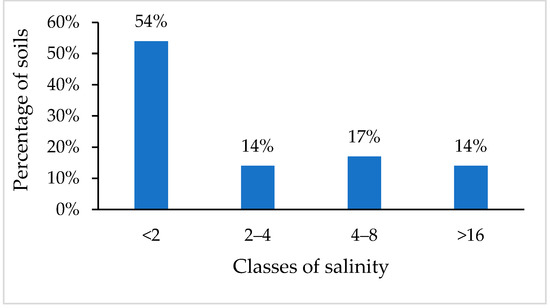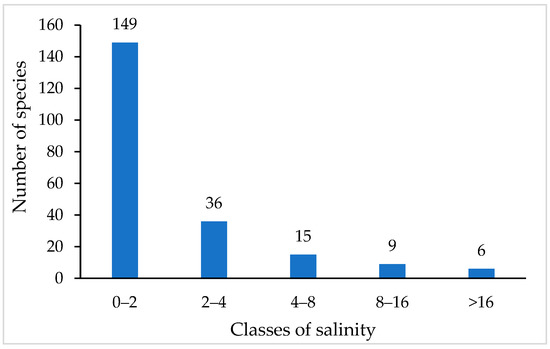Abstract
The arid climate of the Saharan regions is accentuated even more by the consequences of climate change and environmental threats, thus affecting normal plant development. The salinization of soils is one of the major stresses in the Moroccan Sahara Desert that strongly penalizes the production. In this sense, it would be interesting to explore the native flora of the target regions, and using it remains the best option to provide sustainable agriculture. The present study is part of a collaborative project with the aim of exploring desert plant species. Different parameters were taken for each species, including soil salinity and density. Two zones showed the highest levels of salinity, Daoura and Akhfennir, both in the Tarfaya province with 19.38 and 24.33 mS/cm, respectively. Although, several species were highly tolerant to salinity and were present at moderate to high densities. Among them, one can cite Aeluropus littoralis (Gouan) Parl., Halocnemum strobilaceum (Pall.) M. Bieb. and Suaeda ifniensis Caball. ex Maire.
1. Introduction
With each passing year, climate change is becoming more intense, especially in desert ecosystems, which strongly impacts major crops. Native desert plant species seem an interesting alternative, as they may play an important role in sustainable development thanks to their environmental and economical values. In addition, they will allow for the exploitation of the existing biodiversity. The target Sahara Desert covers an area of about 270 km2. The lasted botanical expeditions held in this area in 2021 revealed that it shelters around 360 species of which 328 are entirely identified. Those species belong to 29 orders, 58 families, and 207 genera. The most common families include Asteraceae, Poaceae, Leguminosae, Amaranthaceae, and Brassicaceae and their prevalence is mainly due to the adaptability to desert conditions. Native species have the ability to survive in areas with harsh conditions: irregular rainfall, high temperatures, saline soils, and scarce water resources. Unfortunately, the large majority of these species are underused or not even known by the inhabitants of the regions.
Salinity is among the major threats in desert areas. Based on soil salinity classes defined by the Food and Agriculture Organization (FAO) [1], 14% of the soils in our study area are very strongly saline. They are mainly concentrated in the coastal zones and the Sabkhas.
With the aim of preserving the rich floral diversity, but also valorizing many species, identification and characterization are deemed to be advantageous. A collaborative project was launched to elaborate an atlas book containing relevant information related to the characteristics, virtues, and indigenous knowledge of native plants. Botanical expeditions were carried out in 2021 and targeted 120 sites in the Sahara Desert.
2. Material and Methods
2.1. Ethnobotanical Field Trips
The ethnobotanical field trips covered 120 sites in the two regions of Laayoune Sakia El Hamra and Dakhla Oued Dahab (Figure 1) which span an area of 270 km2. They are bordered on the north by the Guelmim Oued Noun region and on the south by Mauritania. The itinerary was set up in advance on the basis of remote sensing and with the help of guides who knew the area very well. Whenever a remarkable site was reached, samples of the species and the soil were taken in addition to other crucial parameters for identification: plant density, geographic coordinates, etc.

Figure 1.
Geographic distribution of the visited sites on the map of Morocco.
2.2. Climate
Based on Köppen climate classification [2], the climate in the study area is considered arid. It is characterized by cold winters and dry and very hot summers. On the coastal strip, the temperature tends to be moderate due to the proximity to the Atlantic Ocean. As we move inside the land to the east, the climate becomes drier. As for daylight, it is almost permanent. In terms of rainfall, it is irregular and scarce. The average annual precipitation is around 60 mm [3,4].
2.3. Measured Parameters
2.3.1. Soil Salinity Estimation
Soil samples were taken along the route. Salinity was determined by the electrical conductivity (EC) according to the international standard ISO 11265 [5]. This method consists of using a soil:water ratio of 1:5. The sample was mixed to allow the dissolution of electrolytes, then sieved. The EC was measured using a multiparameter meter (Mettler Toledo, Columbus, OH, USA). The results were displayed in millisiemens per centimeter (mS/cm).
2.3.2. Density
The density of vegetation was represented by a 1–5 scale: 1 being very low density and 5 being very high.
3. Results & Discussion
Soil salinity varied greatly between locations. Figure 2 shows the distribution of the soils by salinity classes according to FAO [1]. Over one-half of the Sahara Desert soils are non-saline whereas moderately saline and very strongly saline soils represent 17% and 14%, respectively.

Figure 2.
Distribution of soil samples according to salinity class.
Two zones of the Tarfaya province displayed the highest levels of salinity, Daoura with 19.38 and Akhfennir with 24.33 mS/cm. Still, certain species have shown a high tolerance and were present at moderate to high densities. The distribution of the species by salinity classes is displayed in Figure 3. Around 70% of the species are growing in non-saline soils, while only 15 species are found in strongly saline and very strongly saline soils. They include among others, Aeluropus littoralis (Gouan) Parl., Halocnemum strobilaceum (Pall.) M. Bieb. and the genus Suaeda which can be considered halophytes based on their salt-tolerating capacity and as mentioned in the literature [6,7,8]. Acacia tortilis (Forssk.) Hayne subsp. Tortilis for example, was present in a highly saline location but is not considered a halophyte according to others’ research studies [9,10]. Conversely, the species belonging to the genus Salsola are considered halophytes [11], but none of Salsola longifolia and S. gymnomaschala were encountered in a saline area.

Figure 3.
Distribution of the desert plant species according to salinity class.
4. Conclusions
The present study has enabled us to identify a wide array of species. A selection of them displayed a wide tolerance to high salinity levels. It would be interesting to set up and extend trials to many localities while increasing the number of repetitions to guarantee the durability of performances. Several native desert species were selected as results of several botanical expeditions conducted in 2020–2021 and will be subjected to the domestication process for valorization purposes as feed cosmetic or medicinal plants.
Author Contributions
Conceptualization, A.H.; methodology, A.H. and H.B.; software, A.E.M.; validation, A.H., H.B. and M.D.; formal analysis, A.H.; investigation, H.D.-N., M.I., Y.E.K., A.E.M., M.B. and A.H.; resources, A.H.; data curation, A.H.; writing—original draft preparation, H.D.-N.; writing—review and editing, A.H.; visualization, H.D.-N. and A.E.M.; supervision, A.H.; project administration, A.H.; funding acquisition, A.H. All authors have read and agreed to the published version of the manuscript.
Funding
This research was funded by OCP Phosboucraa Foundation within the project titled “Development of Atlas book on threatened local native plant species of the desert in Laayoune Sakia El Hamra region for various uses”.
Institutional Review Board Statement
Not applicable.
Informed Consent Statement
Not applicable.
Data Availability Statement
Not applicable.
Acknowledgments
The authors gratefully acknowledge the OCP-Phosboucraa Foundation, for providing funds to conduct the project activities. We also appreciate the efforts of different collaborators including local guides.
Conflicts of Interest
The authors declare no conflict of interest.
References
- Abrol, I.P.; Yadav, J.S.P.; Massoud, F.I. Salt-Affected Soils and Their Management; FAO Soils Bulletin No. 39; Food and Agriculture Organization: Rome, Italy, 1988; p. 131. [Google Scholar]
- Arnfield, A.J. Köppen Climate Classification. 2020. Available online: https://www.britannica.com/science/Koppen-climate-classification (accessed on 29 December 2021).
- Haut-Commissariat au Plan. Monographie de la Région Laayoune-Sakia El Hamra, 2020. Available online: https://www.hcp.ma/region-laayoune/attachment/2258177/ (accessed on 2 January 2022).
- Haut-Commissariat au Plan. Monographie de la région Dakhla Oued Dahab, 2018. Available online: https://www.hcp.ma/region-eddakhla/attachment/1410090/ (accessed on 2 January 2022).
- International Organization for Standardization (ISO). ISO 11265:1996 Soil Quality—Determination of the Specific Electrical Conductivity; ISO: Geneva, Switzerland, 1996. [Google Scholar]
- Gulzar, S.; Khan, E. Seed germination of a halophytic grass Aeluropus logopoides. Ann. Botany 2001, 87, 319–324. [Google Scholar] [CrossRef]
- Esmaeli, M.; Dadkhah, N.; Pirdashti, H.; Sepanloo, M. Response of two halophyte plants (Nitraria schoberi and Halocnemum strobilaceum) to potassium sulfate under saline condition. Ukr. J. Ecol. 2017, 7, 359–365. [Google Scholar] [CrossRef][Green Version]
- Fisher, D.D.; Schenk, H.J.; Thorsch, J.A.; Ferren, W.R. Leaf Anatomy and Subgeneric Affiliations of C3 and C4 Species of Suaeda (Chenopodiaceae) in North America. Am. J. Bot. 1997, 84, 1198–1210. [Google Scholar] [CrossRef] [PubMed]
- Alhaddad, F.A.; Abu-Dieyeh, M.H.; ElAzazi ES, M.; Ahmed, T.A. Salt tolerance of selected halophytes at the two initial growth stages for future management options. Sci. Rep. 2021, 11, 10194. [Google Scholar] [CrossRef] [PubMed]
- Veste, M.; Todt, H.; Breckle, S.W. Influence of halophytic hosts on their parasites-the case of Plicosepalus acaciae. AoB Plants 2014, 7, plu084. [Google Scholar] [CrossRef] [PubMed]
- Taia, W.K.; Shiha, M.A.; Al-Kogali, A.A.; Abd-Almaged, A.M. Anatomical and chemo-taxonomical investigations within some Salsola L. species grown in the western costal region of Egypt. Int. J. Sci. Res. 2018, 6. [Google Scholar] [CrossRef]
Publisher’s Note: MDPI stays neutral with regard to jurisdictional claims in published maps and institutional affiliations. |
© 2022 by the authors. Licensee MDPI, Basel, Switzerland. This article is an open access article distributed under the terms and conditions of the Creative Commons Attribution (CC BY) license (https://creativecommons.org/licenses/by/4.0/).